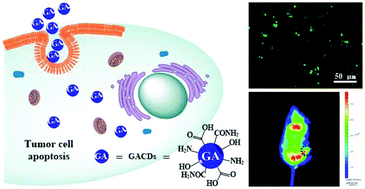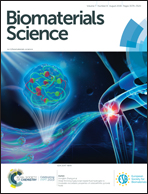Synthesis of dual functional gallic-acid-based carbon dots for bioimaging and antitumor therapy†
Abstract
Carbon quantum dots are excellent photoluminescent materials because of their unique fluorescence properties. They are widely used in biomedical imaging due to their good biocompatibility. However, carbon quantum dots with antitumor activity have rarely been reported. Gallic acid (GA) is an anticancer agent and effective against many types of tumor cells. In this study, GA based carbon dots (GACDs) with fluorescence and antitumor activity were synthesized by a simple microwave-assisted method and characterized by transmission electron microscopy (TEM), and Fourier transformed infrared (FTIR) and X-ray photoelectron spectroscopy (XPS). Studies of optical properties indicated that the GACDs exhibited significant photoluminescence. In addition, we observed the antitumor activity of the GACDs using both cell-based assays and mouse xenograft tumors. Our results demonstrated that the GACDs can be used as both a bioimaging material and an antitumor agent, suggesting their great potential in future clinical applications.



 Please wait while we load your content...
Please wait while we load your content...